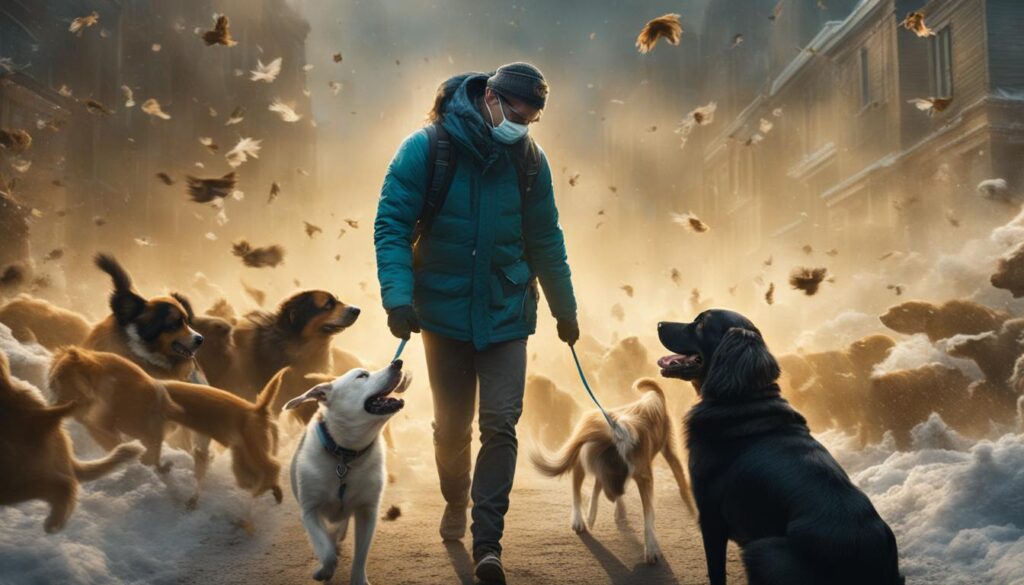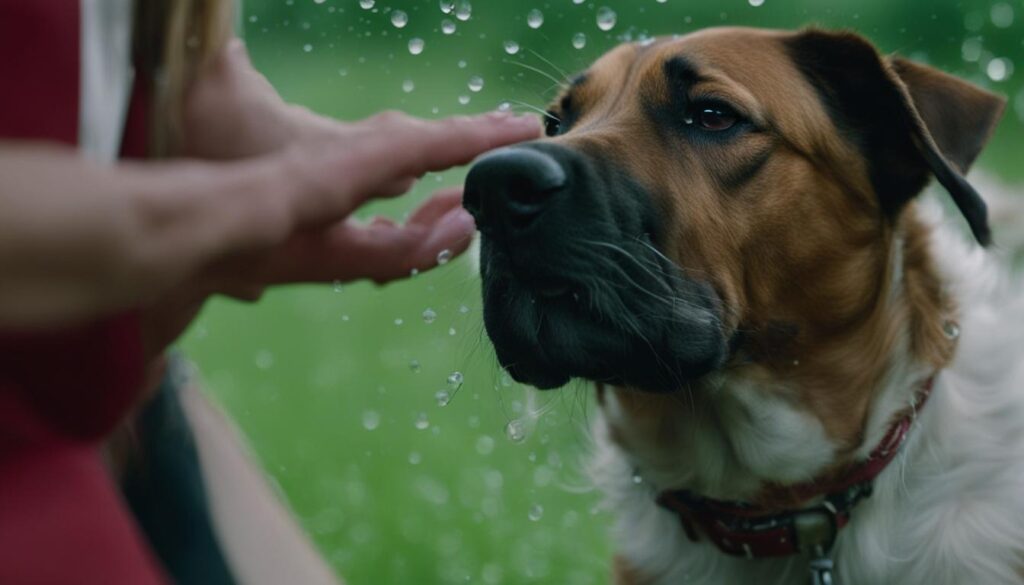As a pet owner, I understand the concerns that arise when it comes to our furry companions’ health. Canine Influenza, commonly known as dog flu, is a respiratory infection that affects dogs. But can dogs catch the flu from humans? Let’s explore that question and gain valuable insights into Canine Influenza and human transmission.
Dogs can indeed become infected with a form of the flu called Canine Influenza. This virus primarily affects the respiratory system and is highly contagious. While dogs are the primary carriers and spread the virus amongst themselves, there is no evidence to suggest that dogs can catch the flu from humans. Canine Influenza is most commonly transmitted through direct contact or exposure to infected dogs.
It’s important to note that some dogs, particularly juveniles, geriatric dogs, and those with weakened immune systems, are more susceptible to contracting infectious diseases. Environments that encourage canine congregation, such as boarding facilities and dog parks, increase the risk of exposure and transmission of diseases.
To protect our dogs from diseases like Canine Influenza, it is crucial to provide them with a healthy lifestyle and reduce their exposure to infectious organisms. These measures help strengthen their immune systems and ensure they can fight off infections effectively.
Key Takeaways:
- Canine Influenza is a respiratory infection that primarily affects dogs.
- Dogs are the primary carriers of Canine Influenza and spread the virus amongst themselves.
- There is no evidence to suggest that dogs can catch the flu from humans.
- Canine Influenza is highly contagious and primarily transmitted through direct contact or exposure to infected dogs.
- Providing dogs with a healthy lifestyle and reducing their exposure to infectious organisms can help prevent Canine Influenza and other infections.
What is Canine Influenza?

Canine Influenza, also known as dog flu, is a respiratory infection caused by the Influenza Type A virus. This highly contagious virus primarily affects the respiratory system of dogs. It was first identified in Florida in 2004 and has since been documented in various parts of the United States.
The Canine Influenza virus can be transmitted through direct contact or exposure to bodily secretions of infected dogs. This can include respiratory droplets expelled when an infected dog coughs or sneezes, as well as contact with contaminated surfaces. While most dogs may show symptoms of the infection, it’s important to note that some dogs can be exposed to the virus and fight off the infection without exhibiting clinical signs.
To give you a visual representation of the spread of Canine Influenza, here’s an engaging infographic:
This infographic illustrates the various modes of transmission for Canine Influenza and emphasizes the importance of taking preventive measures to protect your furry companions from contracting the virus.
Can Dogs Get the Flu from Humans?

While dogs can get infected with Canine Influenza, there is no evidence to suggest that dogs can catch the flu from humans. Canine Influenza is primarily spread among dogs through direct contact or exposure to infected dogs. However, humans can act as carriers and transmit the virus to dogs if they have been exposed to infected dogs and do not practice proper hygiene, such as washing hands after handling dogs.
To better understand the transmission of Canine Influenza, it’s important to note that the flu viruses that affect humans and dogs are different. The types of flu viruses that affect humans are generally not capable of infecting dogs. Dogs have their own strains of influenza viruses, such as H3N8 and H3N2, which are specific to them and cannot be transmitted to humans.
It’s crucial for dog owners to practice good hygiene when handling their pets, especially after being in contact with other dogs. This includes washing hands thoroughly with soap and water to minimize the risk of transmitting any potential pathogens. By taking these precautions, we can help protect both our furry friends and ourselves from the spread of diseases.
Human and canine health are closely intertwined, and it’s our responsibility as pet owners to prioritize the well-being of our four-legged companions. By maintaining good hygiene practices and ensuring a healthy environment for our dogs, we can reduce the risk of influenza transmission and promote their overall health and happiness.
Canine Influenza Transmission and Prevention
Understanding how Canine Influenza is transmitted can help us take necessary precautions to prevent its spread. The virus can be easily transmitted in environments where there are a lot of dogs, such as shelters, boarding centers, dog parks, and veterinary hospitals. It can spread through coughing or sneezing, contact with contaminated surfaces, or direct contact with an infected dog’s nose or mouth.
To prevent dogs from contracting Canine Influenza, it is important to practice good sanitary habits and adhere to the following preventive measures:
- Vaccination: Vaccinating dogs against Canine Influenza is one of the most effective ways to prevent its spread. There are vaccines available for both the H3N8 and H3N2 strains of the virus. Vaccination may not completely prevent infection, but it can significantly reduce the severity and duration of the disease.
- Sanitization: Regularly cleaning and disinfecting surfaces that may come into contact with dogs can help reduce the risk of transmission. This includes dog kennels, toys, water bowls, and grooming equipment.
- Isolation: If a dog shows signs of respiratory tract infection, such as coughing or sneezing, it’s crucial to isolate them from other dogs to prevent the spread of the virus. Providing a separate living space, food bowls, and grooming tools can help minimize the risk of transmission.
By taking these preventive measures, we can help reduce the risk of Canine Influenza transmission and create a safer environment for our furry companions.
| Preventive Measures | Effectiveness |
|---|---|
| Vaccination | Highly effective in reducing the severity and duration of the disease if exposed to the virus |
| Sanitization | Significant in reducing the risk of transmission by eliminating viral particles from surfaces |
| Isolation | Crucial in preventing the spread of the virus by separating infected dogs from healthy ones |
As responsible pet owners, it’s important to stay informed about Canine Influenza and take proactive measures to protect our dogs from the virus. By following proper hygiene practices, getting dogs vaccinated, and minimizing exposure to potentially infected environments, we can help ensure the health and well-being of our beloved pets.
Can Humans Spread the Flu to Dogs?

While dogs cannot catch the flu from humans, there is a potential for humans to spread the influenza virus to dogs under certain circumstances. If humans have been exposed to infected dogs and do not practice proper hygiene, there is a risk of transmission to dogs.
In 2009, humans contracted the H1N1 influenza virus from pigs, and it is reported that cats, dogs, and ferrets fell ill or died after contracting the H1N1 virus from humans. This highlights the importance of taking precautions to prevent the spread of the flu to dogs.
If you have a sick dog or have been in contact with sick dogs, it is crucial to wash your hands thoroughly with soap and water to minimize the risk of transmission to other dogs.
Stay Hygienic to Protect Dogs
Proper hygiene practices are essential when interacting with dogs, especially if they are already sick or vulnerable to infections. Here are some key measures to prevent the spread of the flu from humans to dogs:
- Wash your hands with soap and water before and after handling dogs.
- Avoid close contact with dogs if you have flu-like symptoms.
- If necessary, wear a face mask and gloves when caring for sick dogs.
- Dispose of used tissues and other disposable items properly.
- Clean and disinfect surfaces that may have come into contact with infected dogs, such as bedding, toys, and food/water bowls.
By following these hygiene practices, you can help protect dogs from potential transmission of the flu virus.
Canine Influenza Transmission and Prevention

Canine Influenza, also known as dog flu, is most easily transmitted in environments where there are a lot of dogs, such as shelters, boarding centers, dog parks, and veterinary hospitals. The virus can be spread through various means, including:
- Coughing or sneezing: When an infected dog coughs or sneezes, respiratory droplets containing the virus can become airborne and potentially infect other dogs in close proximity.
- Contact with contaminated surfaces: The virus can survive on surfaces such as toys, water bowls, and bedding. Dogs can become infected if they come into contact with these contaminated surfaces and then touch their nose or mouth.
- Direct contact with an infected dog’s nose or mouth: The virus can be transmitted through direct contact with an infected dog’s respiratory secretions, such as when dogs sniff or lick each other.
Preventing dogs from contracting the virus involves practicing good sanitary habits and taking necessary precautions. Here’s what you can do:
- Thorough handwashing: Wash your hands with soap and water after handling dogs, especially if you have been in contact with an infected dog. This helps prevent the transmission of the virus from dogs to humans and vice versa.
- Vaccination: Make sure your dog is vaccinated with the appropriate canine influenza vaccine. Vaccination can help reduce the severity and duration of the disease if a dog is exposed to the virus.
- Isolation: If your dog is showing signs of Canine Influenza, such as coughing or sneezing, isolate them from other dogs to prevent the spread of the virus.
- Clean and disinfect: Regularly clean and disinfect toys, water bowls, bedding, and other items that dogs come into contact with to eliminate any potential sources of contamination.
- Avoid high-density dog environments: Limit your dog’s exposure to high-density dog environments, such as crowded dog parks or boarding facilities, where the risk of transmission is higher.
Canine Influenza Transmission and Prevention Tips:
“By practicing good sanitary habits, such as thorough handwashing, and ensuring dogs are vaccinated, we can help prevent the transmission of Canine Influenza and protect our furry friends.”
| Transmission Methods | Prevention Measures |
|---|---|
| Coughing or sneezing | Regular handwashing, vaccination |
| Contact with contaminated surfaces | Frequent cleaning and disinfection |
| Direct contact with an infected dog’s nose or mouth | Vaccination, isolation of infected dogs |
Canine Influenza Symptoms
The symptoms of Canine Influenza, also known as dog flu, can vary from dog to dog. Common symptoms include:
- Coughing
- Sneezing
- Loss of appetite
- Fever
- Lethargy
- Red and/or runny eyes
- Runny nose
In severe cases, dogs may develop pneumonia. This can be characterized by:
- Difficulty breathing
- Coughing up blood
- Increased respiratory effort or rate
If you observe any of these symptoms in your dog, it is important to seek veterinary care immediately for proper diagnosis and treatment.
Diagnosis and Treatment of Canine Influenza

When it comes to diagnosing Canine Influenza, a veterinarian will typically perform a physical examination to assess the dog’s symptoms and overall health. In addition, blood tests may be conducted to detect any increase in white blood cells, which is a common sign of infection. X-rays of the dog’s chest may also be taken to assess the condition of the lungs and check for signs of pneumonia.
The treatment for Canine Influenza depends on the severity of the infection. In mild cases, rest and isolation are often recommended to allow the dog’s immune system to fight off the virus. However, in more severe cases, aggressive treatment may be necessary. This can include the administration of antibiotics to combat bacterial infections that may arise as a result of the weakened immune system. Fluid therapy may also be provided to maintain hydration levels, and other supportive measures may be taken to alleviate symptoms.
Cough suppressants may be prescribed to relieve coughing and make the dog more comfortable. These medications help reduce coughing episodes, allowing the dog to rest and recover. Additionally, antibiotics may be prescribed to treat any secondary bacterial infections that may occur as a result of the weakened immune system.
It is crucial for dog owners to follow the veterinarian’s recommended treatment plan for the best possible outcome. This includes administering medication as prescribed, monitoring the dog’s progress, and providing a safe and comfortable environment for recovery.
| Diagnosis and Treatment of Canine Influenza | ||||
|---|---|---|---|---|
| Diagnosis | Physical examination | Blood tests | X-rays | |
| Treatment | Mild cases: rest and isolation | Severe cases: aggressive treatment with antibiotics, fluids, and supportive measures | Cough suppressants to alleviate symptoms | Antibiotics for secondary bacterial infections |
| Guidelines | Follow veterinarian’s recommended treatment plan |
Canine Influenza Vaccination and Prevention

Vaccination plays a key role in preventing the spread of Canine Influenza. There are specific vaccines available to protect against the H3N8 and H3N2 strains of the virus. While the vaccine may not provide 100% effectiveness, it can significantly reduce the severity and duration of the disease if a dog becomes exposed to the virus.
Dogs at high risk of exposure or residing in areas where Canine Influenza is prevalent should be vaccinated annually. This proactive measure helps to build their immunity and lowers the chances of contracting the infection. Consult with your veterinarian to determine the appropriate vaccination schedule for your dog.
In addition to vaccination, practicing good sanitary habits is essential in preventing the spread of Canine Influenza. Regularly washing your hands with soap and water after handling dogs or visiting places with a high dog population reduces the likelihood of cross-species contagion. Avoiding high-density dog environments, such as dog parks and busy boarding facilities, can also minimize the risk of infection.
Maintaining a healthy lifestyle for your dog is another preventive measure. Proper nutrition, regular exercise, and good hygiene contribute to a strong immune system, making your dog more resistant to infections. Ensuring that your dog receives recommended preventive care and lives in a clean and safe environment are important aspects of their overall well-being.
Remember:
Prevention is better than cure. By vaccinating, practicing good sanitary habits, and maintaining a healthy lifestyle for your dog, you can significantly reduce the risk of Canine Influenza and protect their health.
Wrapping Up
After exploring the topic of Canine Influenza and its potential transmission, it is clear that there is no evidence to suggest that dogs can catch the flu from humans. Canine Influenza is highly contagious among dogs and can spread easily in environments where there is a high concentration of dogs.
However, dog owners can take several measures to prevent their pets from getting infected. Vaccination is an essential step in protecting dogs from Canine Influenza, and it is recommended for dogs at high risk of exposure or living in areas where the virus is prevalent. Additionally, practicing good sanitary habits, such as washing hands after handling dogs, can help prevent the spread of the virus.
It’s important for dog owners to stay informed about Canine Influenza and take necessary precautions to protect their pets’ health. By ensuring that dogs receive proper vaccination, practicing good hygiene, and maintaining a healthy lifestyle, the risk of dogs contracting the virus can be minimized.
FAQ
Can dogs catch the flu from humans?
A: No, there is no evidence to suggest that dogs can catch the flu from humans. Dogs can, however, become infected with a form of the flu called Canine Influenza.
What is Canine Influenza?
A: Canine Influenza, also known as dog flu, is a respiratory infection caused by the Influenza Type A virus. It primarily affects the respiratory system and is highly contagious among dogs.
Can dogs get the flu from humans?
A: No, dogs cannot catch the flu from humans. Canine Influenza is primarily spread among dogs through direct contact or exposure to infected dogs.
Can humans spread the flu to dogs?
A: Humans can potentially transmit the influenza virus to dogs if they have been exposed to infected dogs and do not practice proper hygiene, such as washing hands after handling dogs.
Canine Influenza transmission and prevention
A: Canine Influenza can be transmitted through coughing or sneezing, contact with contaminated surfaces, or direct contact with an infected dog’s nose or mouth. To prevent dogs from contracting the virus, it is important to practice good sanitary habits and get dogs vaccinated.
What are the symptoms of Canine Influenza?
A: Symptoms of Canine Influenza include coughing, sneezing, loss of appetite, fever, and lethargy. Some dogs may also have red and/or runny eyes and runny nose. Severe cases can lead to pneumonia.
How is Canine Influenza diagnosed and treated?
A: Diagnosis involves physical examination, blood tests, and X-rays. Treatment for mild cases includes rest and isolation, while severe cases may require aggressive treatment with antibiotics, fluids, and supportive measures.
Canine Influenza vaccination and prevention
A: Vaccination is an important measure to prevent Canine Influenza. Dogs at high risk of exposure or living in areas where the virus is common should be vaccinated annually. Good sanitary habits and a healthy lifestyle for dogs also help prevent the spread of the virus.
Can dogs get sick from human influenza?
A: While dogs cannot catch the flu from humans, they can potentially be exposed to the influenza virus if humans have been in contact with infected dogs and do not practice proper hygiene.






